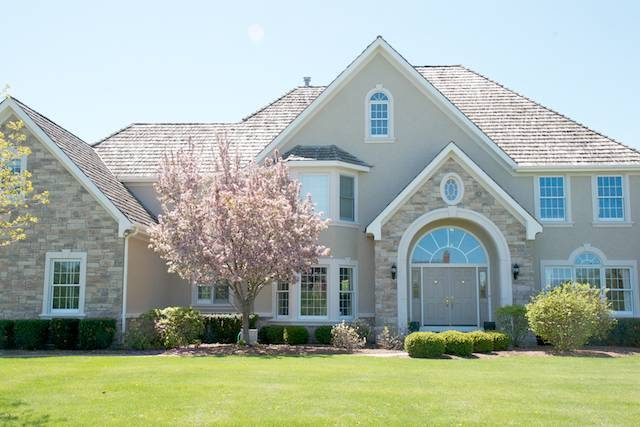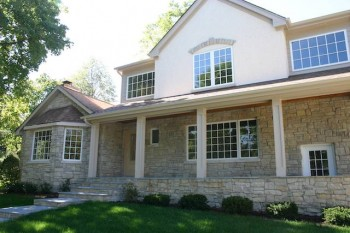
Here at North Star Stone we are passionate about quality housing exteriors, which is why we take such great pride when installing our stone veneer products. Strong, professionally installed exteriors are what we do. In our line of work we have come across housing materials such as synthetic stucco, also commonly known as EIFS or Dryvit, that have caused much distress for the homeowners who are now finding themselves with expensive repairs due to an improperly installed product. To help keep you informed, we thought it would be helpful to talk about synthetic stucco and what it might mean to you as a homeowner or potential home buyer.
What is Synthetic Stucco? A brief history:
Synthetic Stucco, also commonly known by the acronym “EIFS”, which stands for exterior insulation and finish systems, was first used in the manufacturing of homes in Europe in the early 1960’s. Although it looks like stucco, EIFS is actually made of three layered components:
Layer 1: Insulation board
Layer 2: Base coat
Layer 3: Finish coat
EIFS worked well in Europe for several reasons; it provided great insulation and weather protection and it installed nicely on European buildings which tend to have masonry walls, to which the EIFS adhered nicely. In the States we tend to use wood or gypsum, which must have a good moisture barrier for proper installation. Another reason EIFS installed well in Europe is because the materials in the base coat of the EIFS product are slightly different from what was eventually used in the United States, which allowed the European product more flexibility and better waterproofing. In the early 1970’s, an American company by the name of Dryvit Systems introduced EIFS to the American construction market, where it is often referred to as Dryvit.
First used in commercial building, EIFS would eventually make its way into the residential housing industry. Builders were excited about its energy efficiency qualities, which equated to being friendlier on the pocket book. As common sense might suggest, for a product to work the way it is supposed to it must be assembled correctly. This same idea holds very true for EIFS. Unfortunately, along with its introduction into the American housing market came the common practice of cutting corners with EIFS installation. What resulted was not pretty. By the late 1980s Inspectors, homeowners and other interested parties began to notice that many EIFS clad homes were showing extensive signs of water damage. In some instances the damage permeated right through to the framing of the house. The result: a lot of expensive repairs due to mold, dry rot and structural damage. Additionally, EIFS affected homeowners were angry to find themselves facing an unwanted and unplanned expense, while frustrated homebuyers encountered a housing market with limited buying options because of structurally queastionable properties.
Why is EIFS a Problem for a Homeowner who may want to sell?
Due to the following factors, many EIFS homes encountered problems which were later to be faced by their unsuspecting and now quite unhappy homeowners. Because it is a barrier type system, a perfect water barrier is required during EIFS installation over the wood or gypsum sheathing to prevent water from getting into places like windows, doors, roof flashings, deck flashings and vents, to name a few. Because this did not occur, water was able to get in and cause extensive water damage to the wood or gypsum sheathing. Furthermore, homeowners were not aware of the damage because it is hidden and thus not recognizable without a more involved and oftentimes costly inspection by an individual who knows how to inspect EIFS. Those left with improperly installed EIFS are finding themselves with expensive repairs. And lastly, homeowners trying to sell their EIFS clad homes may find themselves with an unsellable property because of water damage they may not have known existed until a home inspection was carried out.
Why Is EIFS a Problem for Home Buyers?
Because water damage can be hard to detect with EIFS without an invasive inspection, the homebuyer may be unaware that water damage exists on the property. Worse still, if the home was improperly inspected and has been purchased, it could be quite a while before water damage due to poorly installed EIFS becomes apparent, which could result in the new homeowners finding themselves with a very expensive repair job. Also, the time, tools and training required by an individual familiar with doing a thorough EIFS inspection can be expensive and invasive, which could be a cost a potential homebuyer is not willing to pay.


What to do if you are trying to sell your EIFS clad home
Be proactive.
-Be prepared to pay for repairs caused by improperly installed EIFS, should repairs be needed. A potential homebuyer may insist on this in the contract and before completing their purchase of the home.
-Consider replacing the EIFS with a stone veneer, Hardie board, actual stucco, or a combination of these materials. Note: before adding new materials to the exterior of your home you may need to replace any damaged sheathing first. This can add to the expense.
-Have your home thoroughly inspected by a certified EIFS inspector.
-Have your home certified if it passes an EIFS inspection.
-Include a warranty on the EIFS for the buyer.
-Be prepared to potentially take a loss on the property. Only the seller can determine if that loss will be worth it.
-Keep accurate records of any repair work done.


What To Do if You are Thinking of Buying an EIFS clad home
-Do your homework. Be familiar with what synthetic stucco is. Understand that a prospective home with EIFS should be thoroughly inspected by a qualified inspector.
-Request a warranty from the seller. Make sure the warranty is paid for.
-Request that the EIFS on the home is certified problem free.
If you like the look of EIFS, consider passing this home up for a home built with real stucco or other exterior like brick, Hardie board or vinyl siding. Finding a different home may be worth the headache of worrying about an EIFS clad home having problems later.
There is a stigma attached to EIFS and this can make it much harder to sell your home later even if it is certified.
Other Options
Although some claim that EIFS have come a long way and many of the problems uncovered with the product in the 80s, 90s and early 2000s have been resolved, there is still a stigma attached to homes finished with synthetic stucco. Fortunately, there are other options on the market today that are customizable, attractive and enduring. Stone veneer, stucco and Hardie board are excellent options and work beautifully when combined with each other. Many people are choosing to go with these highly customizable materials when updating their current home or when in the market for a new home. Homeowners who have needed to replace EIFS on their homes are also turning to Stone veneer and other materials like Hardie board and stucco because of the great flexibility and personalization they offer.
If updating your home with timeless and elegant stone sounds like a promising option to you, consider North Star Stone’s custom colored stone veneer. The experienced professionals at North Star Stone would love to talk with you about this beautiful product. We are also eager to share with you what happy Chicagoland homeowners in Libertyville, Arlington Heights, Barrington and Mount Prospect, are saying about their new beautiful housing exteriors. For more information about adding stone to the exterior of your home, visit our Exterior Stone FAQ page or contact us at info@northstarstone.biz or call 847-996-6850 for a free estimate on your new exterior stone.

